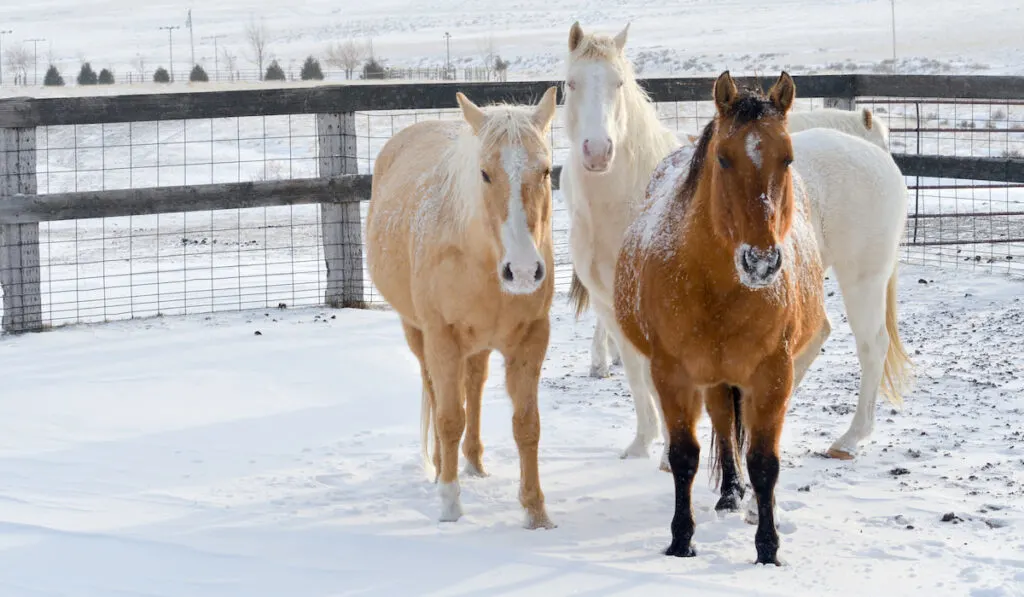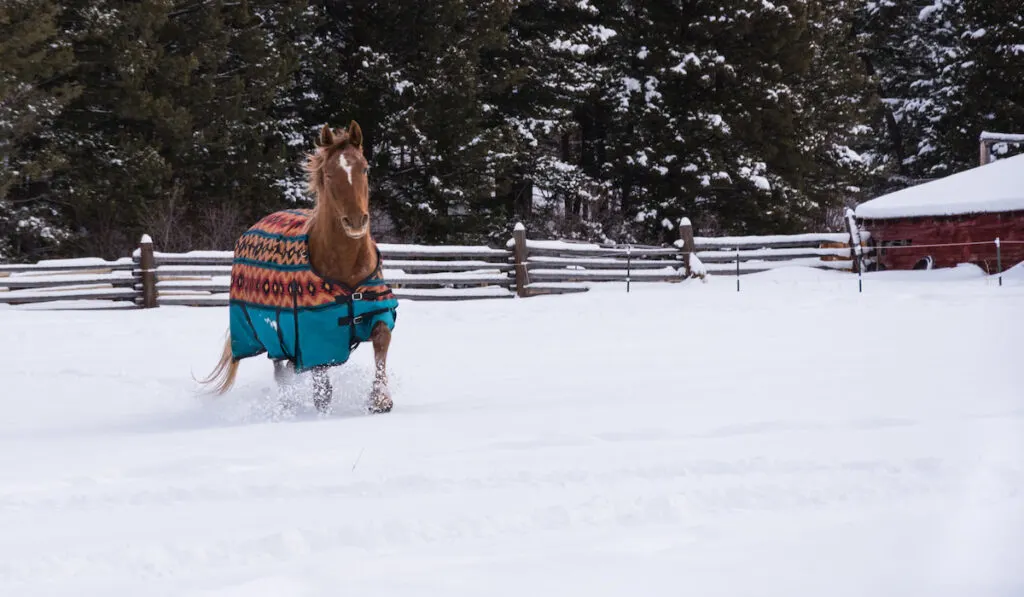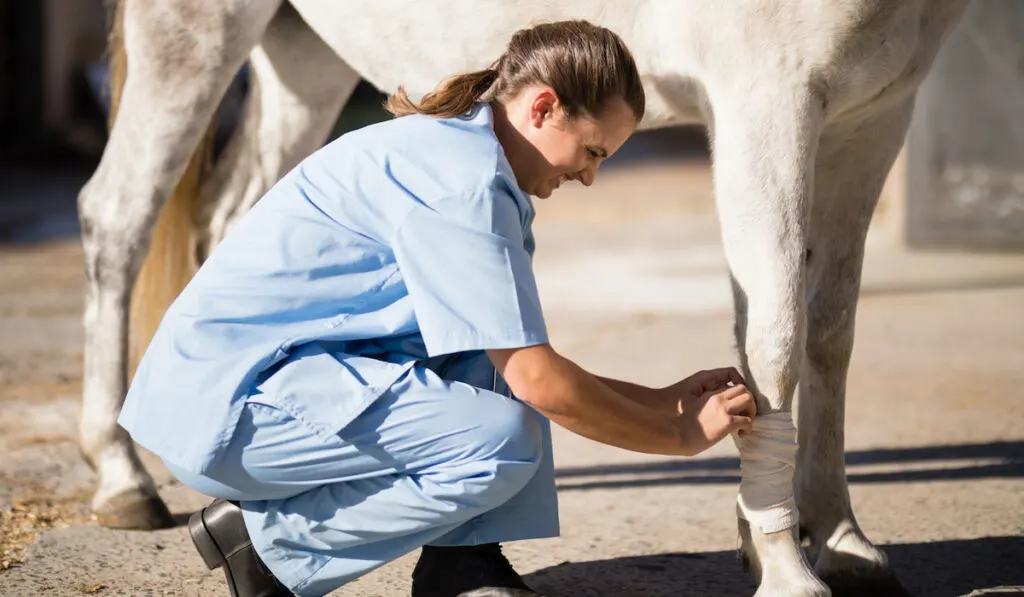If you ride long enough (for any length of time, really) you know it is bound to happen – your trusty steed will need to have their legs iced. Icing your horses legs can be done for any number of reasons: to reduce heat and inflammation, to cool down post exercise, to relieve swelling. It may sound like an almost intimidating arena to enter, but the icing of your horse’s legs can be an important part of your routine. My favorite, general ice boot to have on hand is the Professionals Choice 9 Pocket Ice Boot . But, how do you know which ice boot is best for your barn? Let’s look at the pros and cons of three popular brands.

Table of Contents
Best Ice Boots for Horses
When we consider which type of ice boots to buy for our barn / ranch, we need to look at what we have available on site. Typically, there are two different types of “ice” to use in ice boots. You are either going to use actual ice cubes or crushed ice.
If you have a freezer on site, reusable ice packs will probably be easiest because you can rinse off the ice pack or boot, let it dry and throw it back in the freezer so it is ready next time you need it.
Ice, on the other hand, needs to be made or purchased. If you have a freezer at the barn with an automatic ice maker, this may not be a bad option. If you have to fill trays though or, worse, drive to the store to buy ice, the convenience factor of using reusable ice packs starts to look really good.
The other factor to consider is how often you are actually going to use them. In some barns, horses are iced after every ride. In other barns, icing is limited only to those horses with an issue or when a problem is noticed. The frequency of icing should be factored into the decision you make for ice boots as well.
Professionals Choice Equine Nine Pocket Ice Boot
If I had to buy one full set of ice boots to have on hand it would be the nine pocket ice boot by professionals choice . This is best for me because I don’t ice after every ride. For the occasional horse that needs to be iced for a few days due to an injury, these boots do the trick.
- Professional’s Choice
- Nine inner elastic pockets
Pros:
- Boots work on front or back legs
- Uses crushed or cubed ice
- Comes in pairs.
- Easy to apply
Cons:
- Uses ice cubes.
Professionals Choice Full Leg Ice Boot
Similar in design to the nine pocket ice boot, this product is also excellent but has one key difference. It has sealed pockets pre-filled with a non-toxic freezable gel solution. The Professionals' Choice Full Leg Ice Boot goes in the freezer, the whole boot, and then get’s applied to your horse’s leg when frozen. There is no need to mess with having to buy or make ice.
- Full height boots
- Neoprene exterior
- Nylon lining to protect your horse’s skin
Pros:
- Fits front or rear legs
- Sold in set of two
- Can be frozen and refrozen
- Does not use ice.
- Great for daily / regular use
Cons:
- Takes up some room in the freezer. You would need a large freezer for multiple sets.
- You need multiple sets if you ride multiple horses in a single day.
Finn-Tack Ice Wrap
- ✅ Treat Injury And Swelling: Each pack contains 24 gel pouches which can be frozen beforehand and used to reduce leg pain and inflammation after exercise or injury.
- ✅ Effective Cooling: The wraps are extremely effective and versatile. They can be used on different parts of the leg and other areas where you need flexibility for icing. They can also be left in the freezer between uses. The gel pouches remain soft and comfortable when frozen. 3+ hours of use after freezing.
The Finn-Tack Ice Wrap doesn’t offer as much coverage as the ice boots above but, if you just need to cool tendons and ankles, it is a great option. The boots are sold in pairs and it is easy enough to pop them in the freezer after each use. On the up side, they aren’t as big as the full leg ice boot above so freezer space isn’t as much of an issue.
Pros:
- Fits front or rear legs
- Sold in pairs.
- Can be frozen and refrozen
- Does not use Ice
- Small size is great for daily / regular use
Cons:
- You would need multiple sets if you ride multiple horses in a single day.

Why Would you Ice your Horse’s Legs, Anyway?
Icing a horse’s legs can be a very important part of your cool down after riding. The act of icing serves to prevent soreness, reduce heat and help those recently worked muscles relax safely. It is thought to go a long way to injury prevention, in the form of keeping muscles from being pulled or strained especially.
If your horse is sound and in good form, then icing is the perfect way to ensure they stay that way. If they are showing some inflammation and some heat, icing can help calm that injury right back down.
Basically, there’s a number of good reasons to ice your horse’s legs, from caring for your horse following exercise to preventative maintenance of sorts for reducing injury risk to even helping heal inflammation injuries and strained muscles. Plus, icing is generally an easy and inexpensive way to keep your horse’s legs in tip top and healthy shape.
Should you Ice after Every Ride? Can you Ice after Every Ride?
Now, while icing your horse’s legs is important to do, is it actually necessary to ice them after each ride? Actually – no, it is not.
Icing is most important to do post-exercise or when post-riding in extreme heat and humidity, as it helps with the important and immediate cooling of a horse’s internal body temperature. After the horse’s body itself has cooled down, the care of their legs can begin. Since horses are large and muscular animals being carried around on rather thin legs, it is those leg muscles that can often suffer the most.
In fact, about 60% of a horse’s entire body weight is actually carried on the front legs, rather than a fully even distribution. And due to this brunt of the force landing on those legs, especially if the ground was hard or excessively muddy, those muscles can easily overheat.
It also depends on the type of riding you did. A light hack or some groundwork may not necessarily lead to your horse’s legs needing to be iced. But more strenuous exercise, such as galloping or jumping may stress those muscles. Three-day eventing, especially, is rough on horses’ legs, when there is even a hint of heat and humidity.
Icing very soon after completing the ride can help reduce any growing inflammation before you even can see or feel it beginning at the skin’s surface. The tendons along the back of the legs and joints are especially prone to being overly stressed (notably the hocks, knee joints, fetlocks, etc.)
Best Way – or Ways – to Ice those Legs
The first step in icing is to be aware of your horse’s temperament and manner. Particularly young, spooky or sensitive horses can become nervous with icing at first, as it is a new sensation for them. As with anything new in your horse’s environment, it is necessary to take care to introduce your horse slowly and calmly to this new experience so they feel safe – and you both stay safe in the process.

There is no set in stone “right” way to ice your horse, but there are three basic ways to do it: icing directly in a bucket, cold hosing and using ice boots.
- Icing in a Bucket: Calm, experienced or senior horses may be well at ease doing a simple icing in a bucket filled with cold water and cubes of ice. Picking up your horse’s front legs, one at a time, place them gently into the muck bucket. You will want your horse to ultimately be standing still with each leg well in a bucket. Bear in mind, horses can get antsy and anxious and even just plain fidgety, so it’s important to keep an eye on them. Also of note, this method should only be used for front legs and not back.
- Cold Hosing: Cold hosing is cheap and easy, though perhaps a ways less effective, as it is not as concentrated. Having your horse stand still while you hose cold water over there legs can help reduce swelling, but it may take longer and not cool as deeply.
- Ice Boots: The tack world has many different ice boots available, and in a wide range of pricing options. From more flexible, neoprene boots complete with reusable gel ice packs to ice boots that have space for you to actively pour ice into.
How Long Should you Ice the Legs
Once your horse’s legs are in the bucket (or boot, as it were), it is a common misconception that this is a task that needs to take forever. In fact, all you need is a solid 30 – 40 minutes for the ice to soothe those muscles and for any constricted blood vessels to reopen and blood to flow more uninhibited.
This time spent icing can be spent multitasking, too. Get your horse’s legs cooling and get to doing your routine inspections, untacking, treat giving and plain old quality time with your biggest best friend.
Pros & Cons of Using an Ice Tub vs. Ice Boots
Both the bucket and the boots methods assure the closest cold to skin contact, and the longest amount of time on your horse’s flesh, but each method does come with its own pros and cons, too.
The ice tub method earns points for being not only inexpensive but also easy to set up. The components for it are beyond common and can easily be found at any barn: all you need is a muck or feeding bucket, water and a bag of ice (thank you, local gas stations). You are assured close contact, as your horse’s leg will literally be right in the thick of it with the ice.
There are downsides, however. One being that the horse’s body temperature combined with the open air can soon warm up the water, meaning you may need to be on ice replenishing duty often. Also, the buckets are unwieldy and easy for horses to knock over or cause them to spook. And, while their leg is right in it, the cold is not quite as focused as it would be in a boot.
Ice boots, on the other hand, really drill that cold to a concentrated area. They are more akin to leg wraps or bell boots, too, that your horse may be more used to wearing.
The cons, though, come at a steep price – literally. Ice boots are not always a cheap purchase, with some costing many hundreds of dollars. There are cheaper options, hovering around $50, but may not be as effective and will likely need replacing. The boots also take some time to get used to wrapping and, if not applied properly, will not actually do the cooling work they need to.
Tips for Making Homemade Horse Ice Boots

You do not have to always resort to buying ice boots and can dabble in making your own. Similar to wrapping an injured leg, you can use those same techniques and many of the same implements to make ice boots. Using some vet wrap, some polo wrap and a few squishy gel ice packs, you can have targeted cooling in no time and for much less money.
Don’t have any gel ice packs? One trick horse owner’s swear by is squeezing dish soap into a ziploc baggie and freezing it. It will freeze up cold and still be squishy and pliable to mold around the horse’s leg.
Fresh out of polo wraps? Cut off the tip of old stretchy socks and slide them over those homemade ice packs and you have instant ice boots.
Where to Get Ice?
If you are going to get boots that use ice cubes or you anticipate regular, daily use of ice, you will need an economical place to get it. If you have a refrigerator at the barn with an ice machine, that is a start. Most modern refrigerators will probably produce enough ice to accomodate a few horses.
For larger barns, or barn/tack rooms where you don’t want to hook a water line up to a fridge, consider a dedicated ice machine. There are two types I’d love to try on Amazon.
No products found.
Their is a No products found. that can make up to 24 lbs of ice per day. While that isn’t much for a large barn, it is enough for a few horses.
The free-standing, commercial ice maker does require a water line but can produce up to 100 lbs of ice per day.
- Intense Ice Making Power: We’ve made our commercial ice maker to always be there when you need it. It is capable of producing 99 lbs of ice in 24 hours and quickly makes 45 pieces of clear ice in one cycle within 11-20 mins. With 29 lbs of storage capacity, it holds enough ice to be enjoyed by all
- Freestanding Design with Essential Accessories: Its freestanding design lets you install the ice maker anywhere inside your home, pantry or restaurant. Just make sure to always have a water outlet near your unit. This 17.6 x 15.7 x 31.4″ clear ice cube maker has a sleek, rust-resistant stainless steel interior and comes with a full set of accessories including an ice scoop, water supply hose, water supply connector and a water draining hose
In either case, the price point isn’t cheap but, for frequent icers, the payoff is a savings in time.
Related Posts
- DIY Horse Treats
- Complete Guide to Stall Guards for Horses
- Controlling Rodents: Rat and Mice Control for Your Barn


